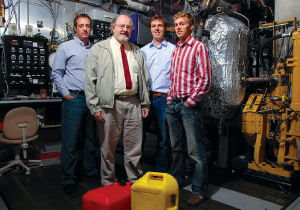
Rolf Reitz: Fuel-mixture technology revolutionizes diesel engine performance
One of the most exciting things about being a research scientist is finding a solution to a long-standing problem that makes the world a better place.
That’s exactly what UW-Madison mechanical engineering professor Rolf Reitz has done with his new clean compression diesel engine technology. By increasing fuel efficiency and reducing toxic emissions, this advanced process conserves precious natural resources, improves human health and reduces environmental damage.
Previous efforts within the industry to design a “clean” diesel engine have had limited success reducing emissions of nitrogen oxides and particulate “soot,” which pollute the air and water and are harmful to the human body. Although “after-treatment” systems can be installed on vehicles to trap these pollutants, they reduce fuel efficiency and are costly to retrofit—two major drawbacks.
State and national governments are passing more stringent regulations to restrict the amount of emissions that can be released from diesel-powered vehicles. To meet this important challenge, Reitz and his students have developed a compression diesel engine combustion process that utilizes in-cylinder fuel blending to successfully reduce emission levels.
“Computer modeling and simulations were used to test the combustion of various fuel models for diesel and gas in the combustion chamber,” says Reitz, who has worked on engine technologies for more than 30 years (the last 21 years with UW-Madison’s Mechanical Engineering Department). “We then did follow-up testing on the best-performing models in the laboratory to verify the results we were seeing in the modeling. We confirmed that by using two fuels of different reactivity and multiple injections, we can control in-cylinder fuel reactivity to optimize combustion phasing, duration and magnitude.”
The first step in the process is the introduction of a low-reactivity fuel into the cylinder (e.g., using port fuel injection) to create a well-mixed charge of low-reactivity fuel, air and re-circulated exhaust gases.
“The level of re-circulated exhaust gas and the closure of the intake valve are controlled so that a high-reactivity fuel can be injected directly into the combustion chamber before ignition of the premixed fuel occurs,” says Reitz.